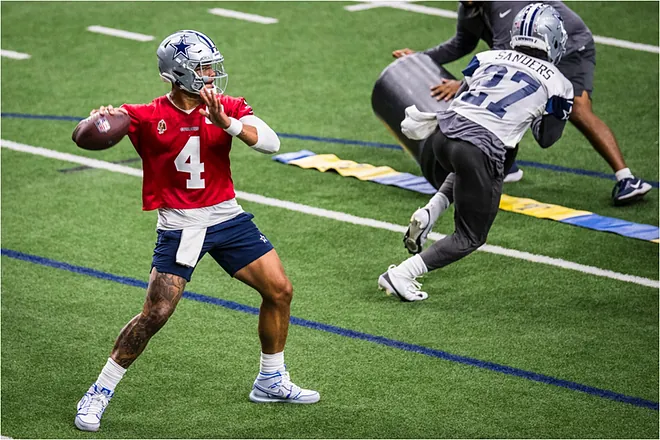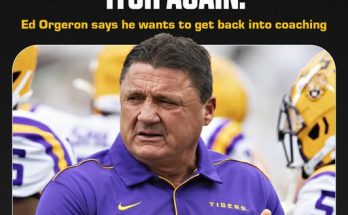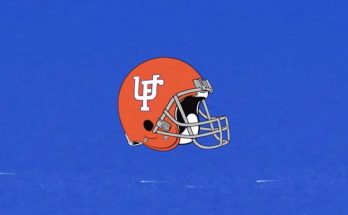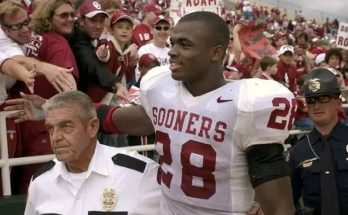The Dallas Cowboys have long been known for building formidable offensive lines that serve as the bedrock for their explosive offenses. But as the 2025 NFL season looms, that identity appears to be slipping—and slipping fast. At the heart of the problem is Dak Prescott’s protection, or rather, the lack thereof. What was once a wall of steel in front of the franchise quarterback now resembles a fragile pane of glass, and the Cowboys might be teetering on the edge of disaster if this isn’t addressed—and quickly.
There is no overstating the importance of a solid offensive line, especially when your quarterback is Dak Prescott, a player who thrives on time, rhythm, and the ability to extend plays. For years, Prescott benefited from one of the most consistent and talented groups in the NFL. Tyron Smith, Zack Martin, Travis Frederick, and La’el Collins were once household names in the trenches, providing elite protection and creating lanes for dynamic runners like Ezekiel Elliott and Tony Pollard. That core, however, has either aged out, retired, or moved on, and now the Cowboys find themselves in unfamiliar territory—trying to rebuild an offensive line on the fly.
The erosion of Dallas’ offensive line didn’t happen overnight, but the effects are being felt more acutely than ever. Tyron Smith, a perennial Pro Bowler and cornerstone left tackle, is now a New York Jet. Zack Martin, still elite when healthy, has been battling a series of injuries and nearing the twilight of his career. The remaining personnel are a patchwork of underwhelming draft picks, unproven rookies, and average journeymen. With minimal continuity and questionable depth, Prescott enters the season behind what may be the weakest unit of his career.
The preseason has already given Cowboys fans reason to worry. In joint practices and early exhibition games, Prescott has faced relentless pressure. He’s been hurried, hit, and sacked at an alarming rate. Even more concerning is the inability of the offensive line to establish a consistent push in the running game. Without a credible rushing threat, defenses can pin their ears back and attack Prescott relentlessly. The chain reaction is devastating: limited play-action opportunities, longer third downs, more turnovers, and more hits on the quarterback. In short, the very structure of the offense is at risk.
For Prescott, the stakes couldn’t be higher. Entering a critical season in which he hopes to secure a long-term extension or solidify his future with the franchise, he now finds himself operating behind a crumbling fortress. The pressure, both literal and figurative, is mounting. Every hit he takes is a potential injury risk, every sack an erosion of confidence, and every hurried throw a ticking time bomb for turnovers. The narrative that Prescott can’t win the big game may not be fair, but without adequate protection, he may not even get the chance to prove otherwise.
Head coach Mike McCarthy and the Cowboys’ front office are acutely aware of the issue, but options are limited this late in the offseason. The free agent market is sparse, and quality offensive linemen rarely become available via trade. That leaves Dallas with only one viable path forward—develop the talent they already have. But development takes time, and time is a luxury the Cowboys can’t afford. In a fiercely competitive NFC East featuring dominant defensive lines in Philadelphia and Washington, Prescott will face a gauntlet of pass rushers almost weekly. If the line doesn’t gel—and fast—the Cowboys’ playoff hopes could evaporate by midseason.
The ripple effects of poor protection extend beyond Prescott. CeeDee Lamb, Brandin Cooks, and Jake Ferguson need time to get open and run precise routes. Tony Pollard, now the lead back after Ezekiel Elliott’s departure, needs holes to hit and space to operate. When the offensive line can’t do its job, every other offensive weapon becomes less effective. Even the defense, which is loaded with talent thanks to stars like Micah Parsons and Trevon Diggs, suffers indirectly. An offense that can’t sustain drives puts the defense back on the field, leading to fatigue and eventually breakdowns.
There’s also the emotional toll to consider. Prescott is a strong leader, but even the most composed quarterbacks can start to show cracks under constant duress. Frustration builds. Confidence wanes. The pressure to make something out of nothing leads to forced throws and unnecessary risks. When a quarterback no longer trusts the pocket, his internal clock accelerates and everything about his mechanics changes. That kind of regression is hard to reverse during the season, especially when the hits keep coming.
Cowboys fans, accustomed to decades of drama and rollercoaster seasons, have every reason to be concerned. The offensive line’s struggles could derail what many hoped would be a season of redemption. After last year’s playoff disappointment, the narrative was supposed to be about revenge, resurgence, and a legitimate Super Bowl push. Instead, it’s shaping up to be a story of survival—one where every game feels like a battle just to keep Prescott upright.
To be fair, there is still a sliver of hope. First-round pick Tyler Guyton, projected to anchor the right side of the line, has shown flashes of brilliance. Young guards like T.J. Bass and Asim Richards have impressed in spurts during camp. If the coaching staff can find the right combination and these young players develop faster than expected, the Cowboys might be able to stabilize things just enough to keep the offense on track. But that’s a huge gamble—and gambles rarely pay off consistently in the NFL trenches.
Meanwhile, Jerry Jones, never shy about making splashy moves, is facing a reckoning. His decades-long approach of prioritizing star power over sustainable roster building is once again under scrutiny. If Prescott is constantly running for his life while the line disintegrates, the finger-pointing will start—first at the front office, then at the coaching staff, and finally at Prescott himself. That’s the cycle in Dallas, and it’s as predictable as it is toxic.
The Cowboys still possess immense talent across the roster. They have elite playmakers on both sides of the ball and a quarterback who, when protected, can compete with the best. But football games are won and lost in the trenches, and right now, Dallas is losing ground—literally and figuratively. If they can’t fix the line, they won’t just lose games; they’ll lose confidence, locker room unity, and perhaps even the belief that this core group can contend for a title.
So where do the Cowboys go from here? In the short term, it’s about survival—scheming around weaknesses, using quick passes to mitigate pressure, relying on tight ends and backs to chip in protection, and getting creative with blocking assignments. Long-term, however, the franchise needs to reestablish its identity up front. That means investing in offensive linemen early and often in the draft, hiring specialized coaches to develop talent, and making the protection of their quarterback the top organizational priority.
If they don’t, the consequences could be far-reaching. Another lost season might mean the end of the Prescott era in Dallas. It could lead to coaching changes, front office shakeups, and yet another rebuild. For a franchise that bills itself as “America’s Team,” mediocrity is never acceptable—and failure is amplified under the blinding lights of AT\&T Stadium.
Dak Prescott is a warrior. He’s proven his toughness time and again, bouncing back from injuries and criticism with resilience and poise. But even the toughest quarterbacks need help. If the Cowboys can’t give him a clean pocket and a fighting chance, they’ll be asking him to do the impossible. And when you ask the impossible too many times, even the most capable stars begin to falter.
The 2025 season could still be salvaged. There’s time, but it’s running out. The alarm bells are ringing, and everyone in Dallas knows it. If Prescott’s protection doesn’t improve soon, the Cowboys won’t just fall short—they’ll collapse. And when the dust settles, they’ll have no one to blame but themselves.



